Overview
Flowering trees cover themselves with blossoms during period of blooming and consequently produce a showy appearance of the landscape. Selecting which trees to plant in your yard is important task that you can’t take too lightly. Whatever tree you choose will hopefully stick around for a long time, so you need to factor things like size at maturity, your purpose for planting it or how well the tree and foliage melds with your existing landscaping.
Although the aesthetics of ornamental trees matter, when it comes to planting trees close to houses, finding the right ones becomes much more important. Therefore, doing your homework before making a final decision can save not only your home’s foundation, but also ensure you will have no regrets and enjoy a landscape you can be proud of for many years to come. The best large and small flowering trees for landscaping generally come in a variety of types as explained below.
Varieties/Types of Flowering Trees For Landscaping
1. Star Magnolia (Magnolia stellata)
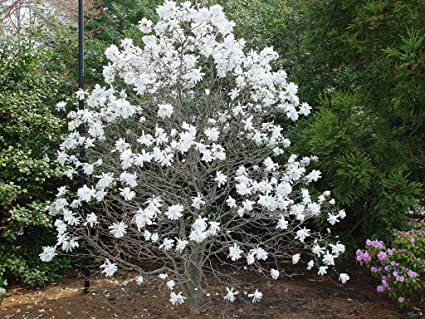
Magnolia stellata, sometimes called the Star magnolia, is a slow-growing shrub or small flowering tree native to Japan. This tree grows 1.5 to 2.5 metres (5 to 8 ft) in height, spreading to 4.6 m (15 ft) in width at maturity. Young trees display upright oval growth, but the plants spread and mound with age.
The tree blooms at a young age, with the slightly fragrant 7–10 cm (3–4 in) wide flowers covering the bare plant in late winter or early spring before the leaves appear. There is natural variation within the flower color, which varies from white to rich pink; the hue of pink magnolias also changes from year to year, depending on day and night air temperatures prior to and during flowering. The flowers are star-shaped, with at least 12 thin, delicate petal-like tepals, some cultivars having more than 30.
2. Dogwood (Cornus florida)
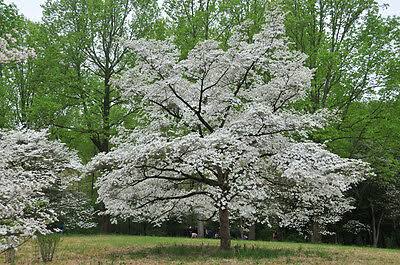
The dogwood, one of the most popular tree around the world, it offers an unmatched four-season display of beauty. The main attraction is the appearance of the showy white or pink flowers (actually bracts) that herald the arrival of spring.
Dogwood flowers have four parts. In many species, the flowers are borne separately in open (but often dense) clusters, while in various other species (such as the flowering dogwood), the flowers themselves are tightly clustered, lacking showy petals, but surrounded by four to six large, typically white petal-like bracts. With species that are native to Asia, Europe, and North America, as well as dozens of cultivars, you’ll have no problem choosing a dogwood suited to your purpose.
3. Weeping Cherry (Prunus pendula ssp)

Prunus pendula is an ornamental weeping cherry tree that has been cultivated in Japan for many centuaries. Their slender and flexible branches lead them to gracefully weep, sometimes almost touching the ground. Once developed, the branches become firm and stiff. In spring, they are clothed in white or pink, single or double flowers, often before the leaves emerge. Small but showy, the blossoms are held in clusters of 2-5 flowers. Weeping cherry trees make a terrific focal point in the landscape, with their black and heavy limbs holding up an umbrella-shaped crown of flowers.
Also Read: Types of Arbovitae For Landscaping
4. Kwanzan Flowering Cherry
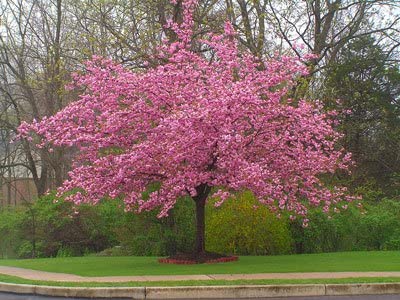
Kwanzan cherry trees grow in a lovely vase shape, with serrated leaves that grow to roughly 4-5 inches in length. Their leaves emerge reddish-copper before turning a glossy, deep green in the summer to yellow and bronze in the fall. The trees grow to be 30-40 feet tall with a 30-40 foot spread, and have a moderate growth rate of 12-24 inches per year.
Kwanzan Cherry Tree blooms in huge clusters of 3 to 5 flowers. These clusters are the thickest of all pink trees and resemble carnations in hue and volume. It begins to bloom in April, with full florals that can last weeks at a time. Basically, the Kwanzan offers four seasons of visual interest, giving you the best yard on the block.
5. Saucer Magnolias (magnolias x soulangiana)
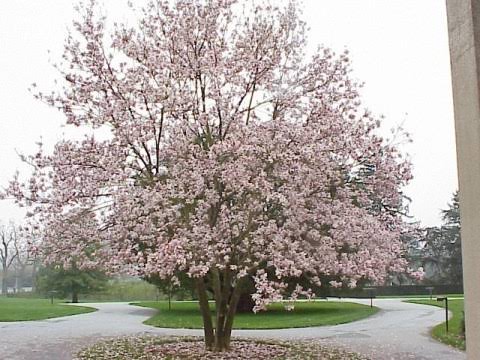
Saucer magnolia is a very popular flowering tree or large shrub that was originally created by cross breeding Magnolia liliflora (lily magnolia, a shrub form) and M. denudata (lilytree). It often grows as a multi-stemmed shrubby plant but can be trained into the form of a small tree. The huge early spring blooms appear before the leaves, but smaller numbers of flowers sometimes continue to bloom after the leaves emerge. The plant has a nicely rounded crown that makes it an ideal landscape specimen. The native species has pinkish-white flowers, but many cultivars are available with pure pink, magenta, and purple flowers.
6. Eastern Redbud (Cercis Canadensis)
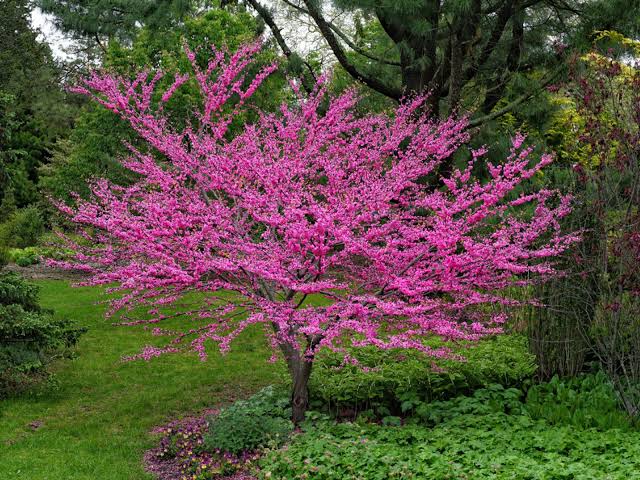
Cercis canadensis, the eastern redbud, is a large deciduous shrub or small tree, native to eastern North America from southern Michigan south to central Mexico, east to New Jersey. The eastern redbud typically grows to 6–9 m (20–30 ft) tall with an 8–10 m (26–33 ft) spread. It generally has a short, often twisted trunk and spreading branches. The bark is dark in color, smooth, later scaly with ridges somewhat apparent, sometimes with maroon patches. The twigs are slender and zigzag, nearly black in color, spotted with lighter lenticels.
The leaves are alternate, simple, and heart shaped with an entire margin, 7–12 cm (3–4.5 in) long and wide, thin and papery, and may be slightly hairy below. The winter buds are tiny, rounded and dark red to chestnut in color. The flowers are showy, light to dark magenta pink in color, 1.5 cm (1⁄2 in) long, appearing in clusters from spring to early summer, on bare stems before the leaves, sometimes on the trunk itself. There are cultivars with white flowers.
Also Read: Types of Cypress Trees
7. Callery Pear (Pyrus calleryana)
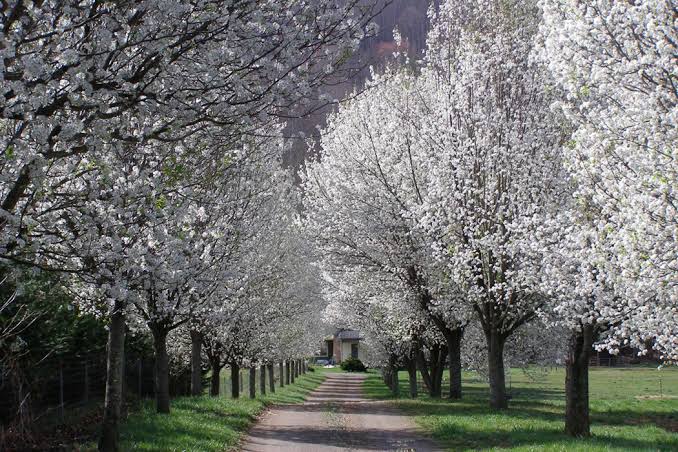
Pyrus calleryana, or the Callery pear, is a species of pear tree in the family Rosaceae. It is most commonly known for its cultivar ‘Bradford’, widely planted throughout the United States and increasingly regarded as an invasive species. Pyrus calleryana is deciduous, growing to 5 to 8 m (16 to 26 ft) tall, often with a conical to rounded crown.
While not a true pear tree in the sense of producing edible fruits (like a common pear tree), the Callery pear (Prunus calleryana) does produce small fruits in autumn. It also has glossy green leaves that turn multiple colors in the fall, including shades of yellow, gold, orange, pink, red and brown, making it a perfect accent tree for seasonal color. If there is an early frost, however, the tree may drop its leaves before they turn color.
The white, five-petaled flowers are about 2 to 2.5 cm (3⁄4 to 1 in) in diameter. They are produced abundantly in early spring, before the leaves expand fully. The blossoms produce a strong, rancid odor. The Callery pear is tolerant of most soil conditions, including alkaline or clay soils. It is native to Vietnam, Korea and China.
8. Hawthorn (Crataegus ssp)
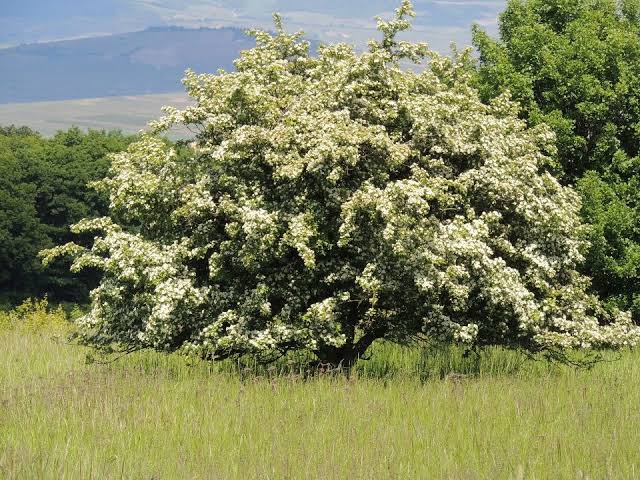
Crataegus, commonly referred to as hawthorn, hawberry, whitehorn is a genus of several hundred species of shrubs and trees native to temperate regions of the Northern Hemisphere in Europe, Asia, North Africa, and North America. Crataegus species are shrubs or small trees, mostly growing to 5–15 m (15–50 ft) tall, with small pome fruit and (usually) thorny branches. The leaves grow spirally arranged on long shoots, and in clusters on spur shoots on the branches or twigs. The leaves of most species have lobed or serrated margins and are somewhat variable in shape.
Hawthorn trees are known for their large clusters of creamy-white flowers covering the tree’s thorny branches when it’s in bloom. Hawthorn tree flowers bloom in mid to late spring, providing magnificent floral displays. Each single hawthorn flower has five petals and emits an intense, musky scent.
Hawthorn flowers grow in flat-topped, broad clusters called corymbs. Depending on the hawthorn species, the flower cluster can be rose or pinkish-red colors. For example, flowers on the Cockspur Hawthorn (Crataegus crus-galli) and Black Hawthorn (Crataegus douglasii) are various shades of pink. But most hawthorn trees produce white flowers.
9. Golden Chain (Laburnum watereri)
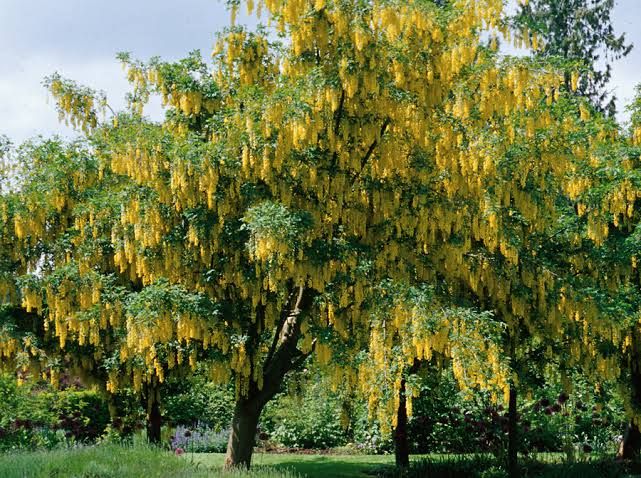
Laburnum, sometimes called golden chain or golden rain, is a genus of two species of small trees in the subfamily Faboideae of the pea family Fabaceae. The species are Laburnum anagyroides—common laburnum and Laburnum alpinum—alpine laburnum. They are native to the mountains of southern Europe from France to the Balkans.
The golden chain tree (Laburnum watereri) is named for the long, pendulus racemes of bright yellow flowers that form on it in spring and early summer, usually mid-May to June. The clusters of small, pea-like yellow flowers can be up to 20 inches long and swing in the wind, creating a very dramatic effect while in bloom.
Although it is a relatively small deciduous tree that can be as short as 12 to 15 feet, the golden chain is capable of reaching heights of 25 to 30 feet. It also spreads to between 15 and 30 feet, though it is generally about 2/3 as wide as it is tall with a narrow, upright spreading habit, giving it an oblong or egg shape. It is a relatively quick grower, adding 2 to 3 feet of height per season, and can be grown as either a tree or a shrub.
Also Read: Trees With Pink Flowers
10. Crape Myrtle (Lagerstroemia indica)
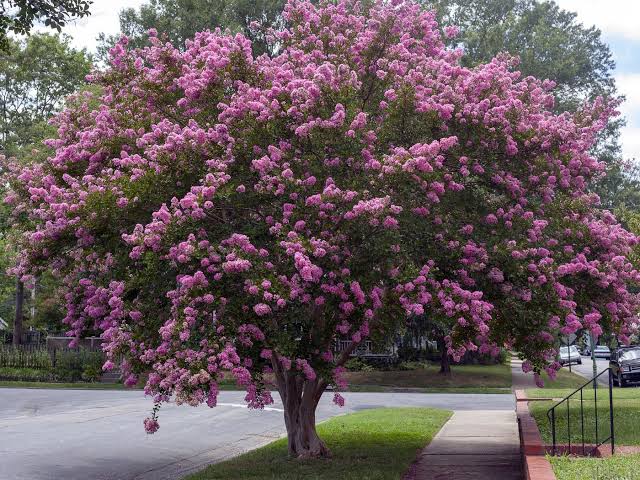
Native to Asia, crape myrtles get their common name from their flowers, which resemble crepe fabric. Depending on the cultivar, crape myrtles range in size from 18-inch shrubs to treelike forms growing up to 40 feet tall and 15 to 25 feet wide. These plants are deciduous and have oblong, green, 2- to 4-inch-long leaves, with larger plants having larger leaves. During fall, crape myrtles brighten the landscape with their yellow, orange and red foliage.
Flowering begins in late spring or summer, although it starts earlier in warmer climates. Depending on the cultivar, large sprays of colorful clusters of blooms festoon the plant in shades of lavender, pink, red, white or purple. After crape myrtles flower, small, brown seeded fruits form. The plants produce multiple trunks and have a habit of producing suckers, although you can prune them to have one main trunk and a more treelike appearance. Crape myrtles grow at a moderate rate, with larger varieties putting on several feet in height during the growing season.
11. American Mountain Ash (Sorbus Americana)
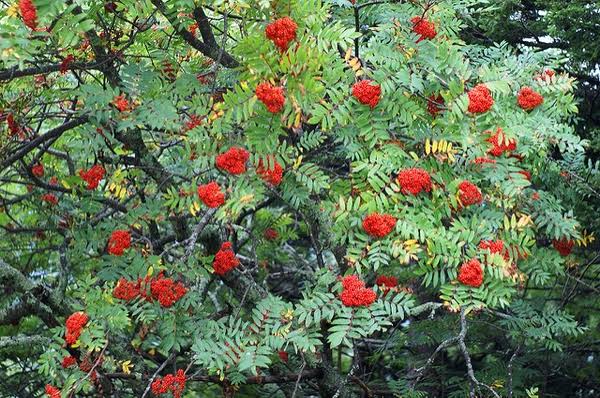
The American mountain ash (Sorbus americana), also known as mountain ash or roundwood, is a deciduous small to medium size tree or shrub in the rose family that is native to northeastern North America from Newfoundland to Georgia. The leaves are alternate, pinnately compound, 6 to 10 inches long with lance-shaped leaflets that are 2 to 3 inches long; fine and sharp toothed margins, dark yellow-green on top and paler beneath.
It typically grows to 15 to 30 feet tall and wide with an open rounded attractive crown. The white spring flowers and bright orange-red fall fruit and foliage add additional interest to this tree. It is relatively short-lived due to fireblight and other diseases and pests.
American Mountain Ash requires moist, rich, acidic, well-drained soils in full sun but tolerates partial shade. It is intolerant of hot humid summers and will do best in the mountain areas. It can be used as a shade tree, in naturalized areas or on slopes.
12. Tulip Tree (Liriodendron tulipifera)

Tulip trees are fall-foliage stars that get their name from the resemblance their flowers bear to the classic tulip flower. They grow rapidly and are Native to North America and the state tree of Kentucky, Tennessee, and Indiana, Tulip trees can be most easily identified by the shape of their leaves, which boast a concave appearance at the ends where you would normally expect a point.
The flowers that give tulip trees their name are yellowish-green, with a touch of orange on the outside. The trees are best planted in early spring once the final frost has passed. They’ll grow rapidly at first (more than 25 inches a year), then slow as they get older. In the spring, the tulip tree draws pollinators like hummingbirds and bees to the nectar in its flowers, while bobwhites, rabbits, squirrels, and other animals prefer to feed on the seed. The cone-like fruit the blooms leave behind also adds ornamental value.
Also Read: Everything To Know About Poplar Trees
13. Tree of Heaven (Ailanthus altissima)
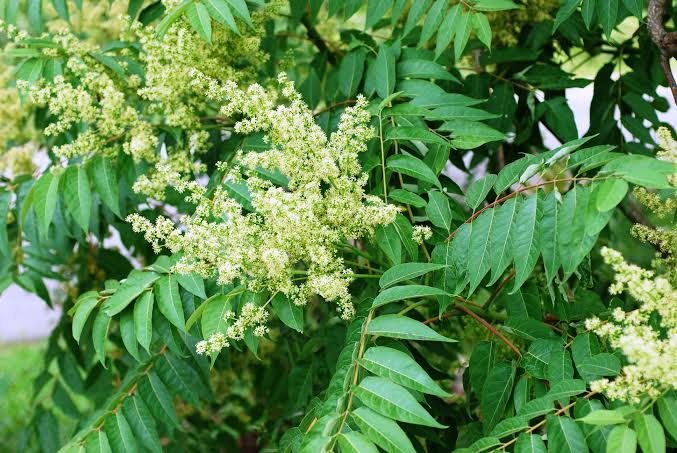
Tree-of-heaven (Ailanthus altissima), commonly referred to as ailanthus, is a rapidly growing deciduous tree native to both northeast and central China, as well as Taiwan. The tree was initially valued as a unique, fast-growing ornamental shade tree with the ability to grow on a wide range of site conditions, tolerating poor soils and air quality.
The branches are light to dark gray in color, smooth, lustrous, and containing raised lenticels that become fissures with age. The buds are finely pubescent, dome shaped, and partially hidden behind the petiole, though they are completely visible in the dormant season at the sinuses of the leaf scars. The ends of the branches become pendulous. All parts of the plant have a distinguishing strong odor that is often likened to peanuts, cashews, or rotting cashews.
The leaves are large, odd- or even-pinnately compound on the stem. They range in size from 30 to 90 cm (1 to 3 feet) in length and contain 10–41 leaflets organised in pairs, with the largest leaves found on vigorous young sprouts. When they emerge in the spring, the leaves are bronze then quickly turn from medium to dark green as they grow.
The flowers are small and appear in large panicles up to 50 cm (20 in) in length at the end of new shoots. The individual flowers are yellowish green to reddish in color, each with five petals and sepals. The sepals are cup-shaped, lobed and united while the petals are valvate (i.e. they meet at the edges without overlapping), white and hairy towards the inside. They appear from mid-April
14. Oleander (Nerium oleander)
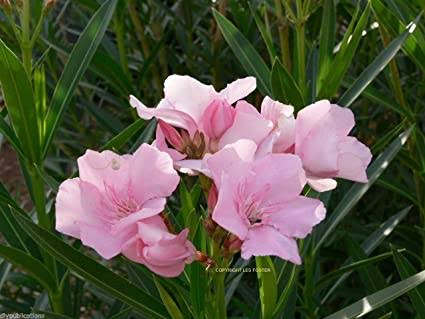
Oleander (Nerium oleander) is a fast-growing evergreen shrub that’s hardy and fairly low-maintenance. It is typically grown as a perennial landscape ornamental in warm climates. It produces fragrant, showy clusters of flowers from around May to October, coming in several color varieties. It is adaptable to many unfavorable conditions, including drought, urban heat, salty air, and poor soil, and it can be planted in spring or fall.
Oleander plants are durable shrubs or trees that contain a gummy, clear sap. The leathery lance-shaped foliage is deep green and may be arranged opposite along the stems or in whorls. Oleander’s funnel-shaped flowers bloom in clusters at the twig tips from summer to fall, and come in shades of white, pink, red, or yellow. The flowers are often abundant, and some oleander varieties give off a pleasant fragrance. Oleanders typically grow to between 6 and 12 feet tall, with a spread of the same width, but some may be trained to grow into small trees that reach up to 20 feet tall.
15. Red Bird of Paradise (Caesalpinia pulcherrima)
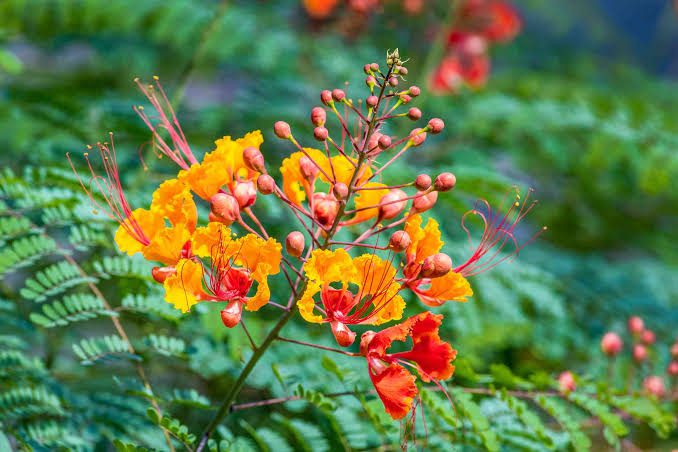
The red bird of paradise (Caesalpinia pulcherrima) a flowering broadleaf evergreen shrub native to tropical and subtropical climates. Unlike many tropical plants, it has a good tolerance for drought, making it a favorite for desert landscapes. These evergreen shrubs feature bright red, orange, and yellow flowers, bowl-shaped and about 2 inches wide, that appear steadily all season long and which attract butterflies and hummingbirds. This shrub grows fast to 8 feet tall with an equal or greater spread. In regions that are totally frost free, it can grow up to 10 feet tall. Its medium green, compound leaves contain up to nine sections, each of which has up to twelve pairs of small leaflets.
Red bird of paradise is extremely tough, easy to care for, and affordable. Also known as pride of Barbados or peacock flower, this is a popular shrub for tall hedges and screens in warm climates—zones 9 and higher. They are quite popular in dry southwestern states, including Arizona and New Mexico. These bright and showy shrubs can be grown as a boundary between lawns or around a pool, or to screen a chain-link fence.
Also Read: Difference Between Evergreen And Deciduous Trees
16. Smoke Tree/Bush (Cotinus coggygria)

The smoke tree is an upright spreading deciduous shrub or small tree in the cashew family. It is native to the warm temperate northern hemisphere. It is also commonly known as royal purple smoke bush, smokebush, smoke tree, and purple smoke tree. The name “smoke bush” derives from billowy hairs attached to the flower clusters which remain in place through the summer, turning a smoky pink to purplish-pink as the weeks progress.
The flowers are showy, wispy, and airy. They consist of many filaments which make up a cloud of color on the current season’s growth. The color of the flowering is largely a smoky pink to light purplish-pink which is dependent on the cultivar. In the garden, this plant is best used as a large accent plant or single specimen. This plant has a fibrous root system which is easy to transplant, and once established, is drought tolerant.
17. American Chestnut Tree(Castanea dentate)

The American chestnut tree (Castanea dentata) is native to northeastern North America. It is a deciduous tree with oblong leaves of a medium or dark green color, which in fall turn bronze or gold. The American chestnut tree has a moderate growth rate, generally growing 2 to 3 feet per season. It generally grows to a height of 50 to 75 feet, though it is capable of growing between 80 and 100 feet. Because it also has a spread of roughly 50 to 75 feet, the American chestnut has a round-looking or “globular” spreading crown. Showy green or yellow flowers appear in springtime, usually around June, and give way to fruit in fall. These fruit are the classic chestnut, whose shells are enclosed in a spiny ball about 1 1/2 to 3 inches wide.
18. Horse chestnut Tree (Aesculus hippocastanum)

Aesculus hippocastanum, the horse chestnut, is a species of flowering plant sometimes called horse-chestnut, European horsechestnut, buckeye, and conker tree. The leaves are opposite and palmately compound, with 5–7 leaflets; each leaflet is 13–30 cm (5–12 in) long. The flowers are usually white with a yellow to pink blotch at the base of the petals they are produced in spring in erect panicles 10–30 cm (4–12 in) tall with about 20–50 flowers on each panicle. Its pollens are not poisonous for honey bees. The limbs of horse chestnuts are often twisted and oddly shaped, making them an interesting tree to grow as specimen pieces in a landscaping design.
19. Crabapple Tree (Malus spp.)
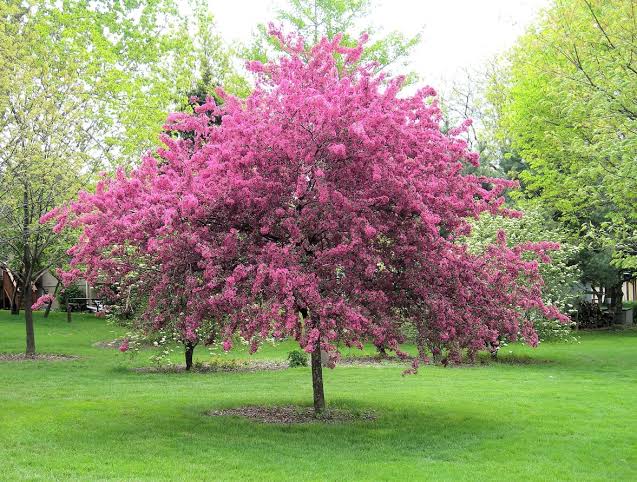
Crabapple trees (Malus spp.) come in two varieties: ornamental, also known as “flowering,” and fruiting. Fruiting trees produce small- to medium-sized, sour apples, often used for jelly. Ornamental crabapples are bred for their beautiful pink or white blossoms. Once planted, these trees can live a long time, with only occasional pruning to shape them. These trees are native to temperate regions of North America, Europe and Asia, and are believed to have originated in central Asia in Kazakhstan.
Also known as “jewels of the landscape,” crabapple trees remain attractive throughout the year. The fragrant flowers range from pure white to deep, reddish pink and may be double, semi-double or single. The trees may be rounded, weeping, vase-shaped, oval or spreading. Heights vary by species and cultivar, but generally range from dwarf forms at around 8 feet tall to standard crabapples that may grow up to 25 feet tall.
The foliage of most types of crabapple turn brilliant shades of red, yellow or gold in fall. Fruit appears from summer to fall and are 2 inches in diameter or less. Larger fruits are classified as apples. Fruit color ranges from green to dark, purplish red.
20. Mimosa Tree (Albizia julibrissin)

Admired for its fernlike foliage and strikingly fluffy, pink-tinged flowers, the mimosa tree (Albizia julibrissin) has been planted as a garden ornamental in the United States since the 18th century. The deciduous tree grows quickly to a height of about 35 feet, showcasing a broad, open canopy with a picturesque silhouette. Mimosas are quick to establish and tolerant of a range of cultural conditions, though they are notably susceptible to some pests and diseases.
Mimosa trees are drought tolerant, though the University of Florida states that the trees will have greener, more lush foliage if watered regularly during the growing season. The tree can cause a significant amount of litter from dropped flowers, leaves, seedpods, and even branches and limbs, requiring regular sweeping and clearing to keep the area around it neat. Mimosa trees self-sow freely, so take care to remove any seedlings that pop up near the tree, unless you’re hoping for a mimosa grove.
Also Read: Different Types of Maple Trees For Landscaping
21. Common Fringe Tree (C. virginicus)

The common fringe tree (C. virginicus), also called old man’s beard, reaches a height of 12 to 20 feet with an equal spread at maturity. It covers itself in drooping, 6-inch-long clusters of small white, fragrant flowers from May through June, with male and female flowers on separate trees. If you grow both a male and female tree, flowers on the female tree produce small fruits resembling bluish-black olives that attract birds and wildlife.
Fringe trees are suitable for growing in U.S. Department of Agriculture plant hardiness zones 3 through 9. A second species, called the Chinese fringe tree (C. retusus), has similar flowers and fruit but a more shrub-like growth habit, usually with many stems, and reaches a height of 10 to 20 feet when mature. It does best in USDA zones 5 through 9.
22. Flowering Almond (Prunus glandulosa)

Flowering almond (Prunus glandulosa) is a highly ornamental shrub grown for its breathtaking early spring display. It’s exceptionally cold hardy and is one of the first shrubs to bloom in the springtime, and it can grow up to 12 feet in height. It’s a fairly resilient plant that’s easy to care for, provided you know about its specific water, soil and fertilizer requirements, and how to combat pests and diseases.
Flowering almond (Prunus triloba) leaves have an elongated oval shape that are typically medium- and gray-green. Leaves are around 1 to 2 inches long, while those of the dwarf flowering almond (Prunus glandulosa) are typically less than an inch long. The flowering almond bush produces five-petal blooms, which may be either white or pink, early in February or March.
23. Golden rain Tree (Koelreuteria paniculata)
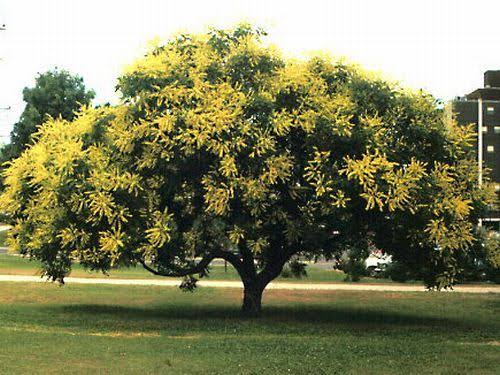
Golden rain tree (Koelreuteria paniculata) is a deciduous member of the soapberry (Sapindaceae) family that offers an impressive range of ornamental features. A native of North Korea and China, the tree boasts panicles of bright yellow, summer blooming flowers; lantern-like, papery seed capsules; and feathery leaves that shift from pinkish or purplish bronze in the spring to green in the summer and yellow in the fall. The tree is on the small side, growing to a mature height between 30 to 40 feet with a nearly equal spread. Golden rain tree is an adaptable, lovely tree that tolerates less than ideal urban conditions.
24. Ivory Silk Lilac Tree (Syringa reticulata “Ivory Silk”)

Whether tall as trees, or small as medium-sized bushes, lilacs (Syringa spp.) are known for their heady perfume and abundant displays. Towering lilacs look like trees, and some varieties are called tree lilacs, but their many stems cause gardening experts to classify lilacs as bushes or shrubs.
“Ivory Silk” tree lilac (Syringa reticulata “Ivory Silk”) grows as tall as a small tree, reaching 20 to 25 feet tall and 15 to 20 feet wide. Suitable for U.S. Department of Agriculture plant hardiness zones 4 through 9, it bears fragrant white summer flowers that attract hummingbirds and butterflies.
25. Greenspire Linden
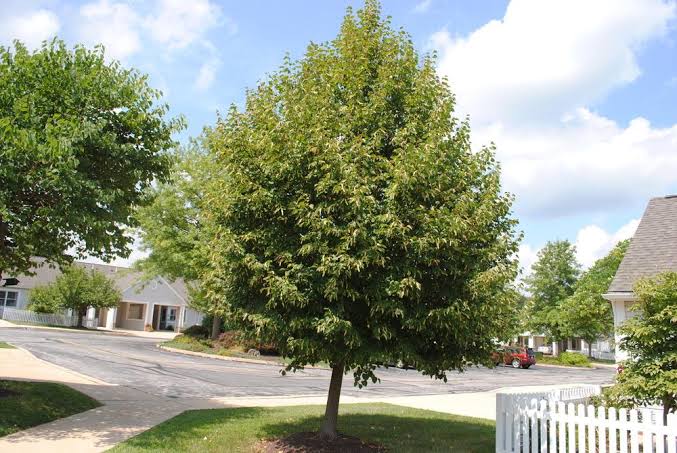
Greenspire linden is a magnificent shade tree with a strong, spire-like shape throughout its life and fragrant yellow flowers in early summer when few trees bloom. It is very tidy and low-maintenance, adaptable, and makes an excellent lawn or street specimen, or by a pool or deck.
Greenspire linden has dark green foliage throughout the season. The heart-shaped leaves turn an outstanding gold in the fall. It features subtle clusters of fragrant yellow flowers with tan bracts hanging below the branches in early summer. The tree will grow to be about 50 feet tall at maturity, with a spread of 30 feet. It has a high canopy with a typical clearance of 6 feet from the ground, and should not be planted underneath power lines.
Also Read: Types of Evergreen Trees
26. Thundercloud Plum (Prunus cerasifera “Thundercloud”)

The Flowering Plum Tree ‘Thundercloud’ is a small deciduous tree commonly planted for its deep reddish-purple leaves and white-pale pink flowers that are among the first to appear in the spring. It is an excellent shade tree for any garden, reaching a maximum height of about 20 feet, with a canopy of equal size. Prunus cerasifera is commonly called cherry plum. It is native to western Asia and the Caucasus.
‘Thundercloud’ is a purple-leaved cultivar that typically grows as a dense, upright-spreading tree to 15-25′ tall. It has become a very popular ornamental landscape tree in large part because its showy purple foliage retains excellent color throughout the growing season. Thundercloud grows best in U.S. Department of Agriculture plant hardiness zones 4 through 9, which means it can withstand freezing temperatures.
27. Newport Plum (Prunus cerasifera ‘Newportii’)
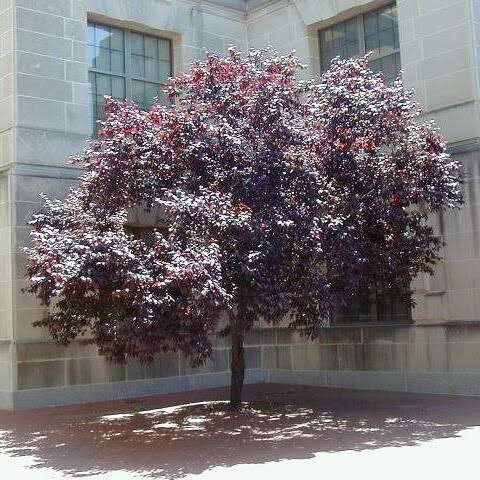
The Newport Flowering Plum Tree is a popular ornamental tree, perfect for providing some light shade in smaller yards. Newport plum trees are often used as ornamental shade plants. It is a deciduous tree that grows 15 to 20 feet (4.5 to 6 m.) tall with spectacular purple-bronze foliage. Springtime brings sweet little purplish pink blossoms and lovely purple drupes form in summer. Even once the leaves and fruits are gone, the upright, vase-like form of the branches creates an attractive scene when covered in winter’s snowy glory. This small tree or shrub will definitely stand-out in your landscape with its contrasting color.
28. Red maple (Acer rubrum)

The red maple (Acer rubrum) is a sprawling deciduous tree native to Eastern North America, naturally growing in spots as diverse as Quebec, Florida and Texas. While many maple tree varieties sport ruddy red, yellow and orange leaves in the fall, the Acer rubrum species truly earns the name “red maple”. Green stems from spring through fall turn red in winter, new foliage emerges red and turns green at maturity. Then, in fall, the tree explodes into a fireball of dark red and/or yellow. Even its spring-blooming flowers are often red.
The red maple grows to a height of 60 feet, with a 40-foot spread in U.S. Department of Agriculture plant hardiness zones 3 through 9. Red maple hybrid cultivars are typically smaller and some are faster growing or have columnar or rounded shapes.
29. Purple-robe Locust Tree (Robinia pseudoacacia)
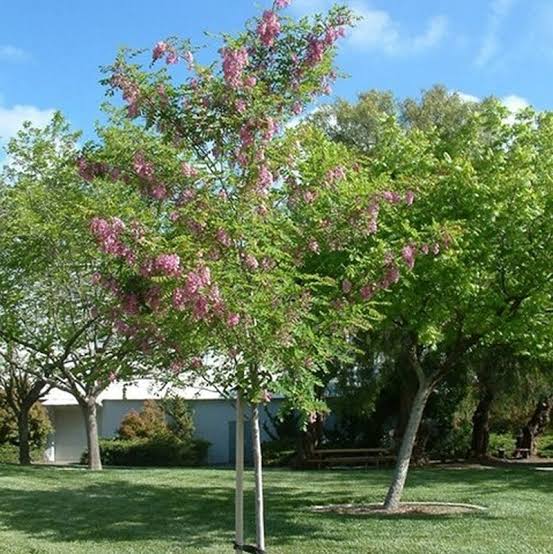
Robinia pseudoacacia “Purple Robe” is commonly known as the purple-robe locust due to its fragrant wisteria-like purple blossoms that appear in the spring. Colorful foliage throughout much of the year and an attractive shape add to this tree’s appeal for the home landscape.
Purple-robe locust trees grow at a fast rate of 2 to 3 feet per year, reaching a mature height of 40 to 50 feet, with a spread of up to 30 feet. The pinnate leaves emerge in the spring as a bronze-red, turning to blue-green during summer and yellow in the fall. The sweet-smelling flowers, which last for a 10-day period in late spring, are followed by 4-inch leathery purple-brown seed pods that persist on trees all winter. The short, irregular branches and tight canopy cast a medium shade below the tree that allows a lawn to grow.
30. Peking lilac (Syringa pekinensis)

Peking lilac (Syringa pekinensis) is a deciduous shrub or small tree from the tree lilac family. It has a finer texture (due to smaller leaves and stems), smaller flowers, and its variable colorful bark, which exfoliates in thin flakes or sheets. The leaves are dark green whereas its flowers are smaller than the Japanese tree lilac, Syringa reticulata. It grows between 15 and 24 feet tall and bears 6-inch, creamy white summer flowers.
Also Read: Different Types of Hibiscus Trees
31. Jacaranda (Jacaranda mimosifolia)

Jacaranda (Jacaranda mimosifolia) is a native of warm regions of South America, and in the United States and a common flowering tree that is used for landscaping in many homes around the world.The upright, rounded growth habit and purple-blue clusters of trumpet-shaped flowers offer notoriety to the jacaranda tree (Jacaranda mimosifolia). Its open, spreading branches and finely-texture leaves gives credence to its use in the landscape as a shade tree. Jacaranda trees require minimal, basic care in order to thrive, allowing both beginning and expert gardeners to grow it successfully.
Mature jacaranda trees can reach heights of between 25 and 40 feet, and their horizontal spread may be even wider, making them impressive garden specimens that need plenty of room to grow. The arching habit of their branches also makes them attractive street trees, as their branches will often grow over and shade the street.
32. Black chokeberry (Aronia melanocarpa)

Black chokeberry (Aronia melanocarpa) is a deciduous shrub that is native to the eastern part of North America. It grows in an upright and fairly rounded shape. Its glossy, dark green leaves are around 1 to 3 inches long and either lanceolate or elliptical in shape.
The foliage turns red to reddish purple in the fall, providing striking color to the landscape before dropping off the plant for winter. Clusters of small five-petaled flowers appear in the spring, and purplish black to black fruits that are around the size of blueberries appear in the late summer to fall. Black chokeberry has a slow to moderate growth rate and can be planted in the fall or spring.
Further References
- Flowering Trees: https://www.thespruce.com/types-of-flowering-trees-4069714
- Flowering Trees For Landscaping: https://arbordayblog.org/landscapedesign/top-10-flowering-trees/
- Trees With Orange Flowers: https://homeguides.sfgate.com/flowering-trees-with-bright-orange-blossoms-in-florida-13404296.html